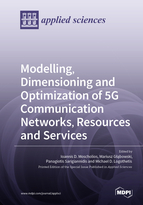Modelling, Dimensioning and Optimization of 5G Communication Networks, Resources and Services
A special issue of Applied Sciences (ISSN 2076-3417). This special issue belongs to the section "Electrical, Electronics and Communications Engineering".
Deadline for manuscript submissions: 29 April 2024 | Viewed by 56726
Special Issue Editors
Interests: teletraffic engineering; performance evaluation and optimization of telecommunication networks; protocol analysis; network simulation; network planning; queueing theory
Special Issues, Collections and Topics in MDPI journals
Interests: tele-traffic; performance evaluation; communications networks; switching and routing; traffic control; elastic optical switching networks
Special Issues, Collections and Topics in MDPI journals
Interests: IoT; 5G mobile communication; UAV; quality of service; radio access networks; computer network security; radio networks; artificial intelligence
Special Issues, Collections and Topics in MDPI journals
Special Issue Information
Dear Colleagues,
Designing, dimensioning and optimization of communication networks resources and services have been an inseparable part of the development of telecommunications and ICT infrastructure from the very beginning of their existence. These networking problems have changed substantially over the recent years as a result of the changes in users’ requirements for the communications convergent multi-service wired and wireless networks.
The global network of 5G remains a network of many heterogeneous systems interacting with each other, and widely used broadband mobile devices and cloud computing have given rise to a tremendous growth in network traffic. Contemporary telecom networks must carry large amounts of traffic and provide service to traffic streams with very much differentiated demands, not only in terms of bit-rate and service time but also of demanded quality of service (quality of experience) parameters. In such a communication infrastructure, there are important challenges, including the study of necessary multi-layer cooperation, new protocols, performance evaluation of different network parts, low layer network design, network management and security issues, new technologies in general.
Each and every newly introduced type of a network technology is followed by a substantial increase in both the number and the complexity of problems that need to be resolved by theoreticians and engineers. No matter what these developing changes may bring, the essential tasks for modern communication 4networks remain the same: (1) to develop new technologies offering increasing network capacity, (2) to determine and evaluate the relationship between the quality of service (quality of experience) parameters and the parameters characterizing traffic sources (services), (3) to control and optimize the usage of network resources, (4) to enhance the capabilities of data transport, transmission and reception between end users and the core network. These tasks provide a basis for developing engineering algorithms and tools used for designing, analysis, dimensioning and optimization of wired and wireless systems and networks.
The objective of this special issue is to bring together the state-of-the-art research contributions that address challenges in contemporary networks design, dimensioning and optimization.
The topics of primary interest include, but are not limited to:
- Analytical and simulation models of 5G communication networks
- Performance evaluation of 5G communication networks
- Planning of 5G networks and services
- Dimensioning of 5G communication network resources
- Optimization techniques for 5G communication network resources
- Resource management tools for 5G communication networks
- Optical backhauling in 5G networks
- BBU placement and management in 5G networks
- Energy efficient 5G networks
- 5G heterogeneous network deployment models
- Big Data-supported resource allocation in 5G networks
- Virtualization technologies in 5G networks
- Passive optical networks in 5G networks
- BBU optimization in 5G networks
- BBU-RRH deployment and strategies.
- BBU-RRH placement and optimization.
Prof. Dr. Ioannis D. Moscholios
Prof. Dr. Mariusz Głąbowski
Prof. Dr. Panagiotis Sarigiannidis
Prof. Dr. Michael D. Logothetis
Guest Editors
Manuscript Submission Information
Manuscripts should be submitted online at www.mdpi.com by registering and logging in to this website. Once you are registered, click here to go to the submission form. Manuscripts can be submitted until the deadline. All submissions that pass pre-check are peer-reviewed. Accepted papers will be published continuously in the journal (as soon as accepted) and will be listed together on the special issue website. Research articles, review articles as well as short communications are invited. For planned papers, a title and short abstract (about 100 words) can be sent to the Editorial Office for announcement on this website.
Submitted manuscripts should not have been published previously, nor be under consideration for publication elsewhere (except conference proceedings papers). All manuscripts are thoroughly refereed through a single-blind peer-review process. A guide for authors and other relevant information for submission of manuscripts is available on the Instructions for Authors page. Applied Sciences is an international peer-reviewed open access semimonthly journal published by MDPI.
Please visit the Instructions for Authors page before submitting a manuscript. The Article Processing Charge (APC) for publication in this open access journal is 2400 CHF (Swiss Francs). Submitted papers should be well formatted and use good English. Authors may use MDPI's English editing service prior to publication or during author revisions.









